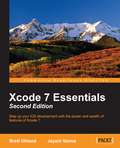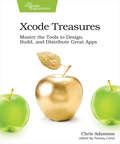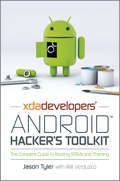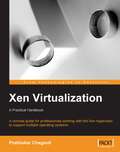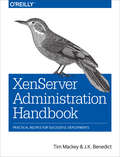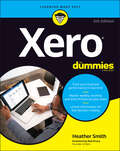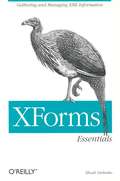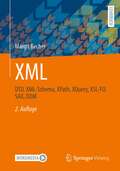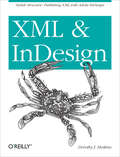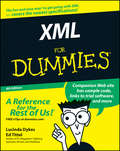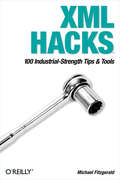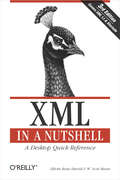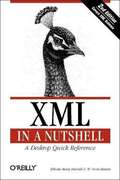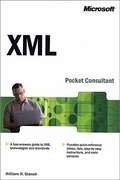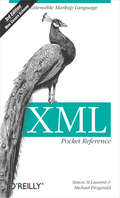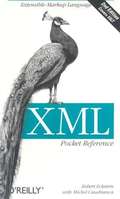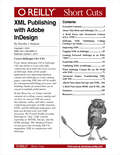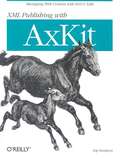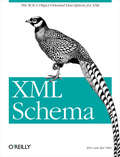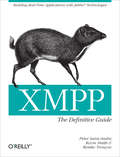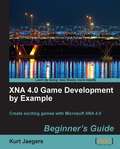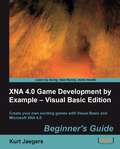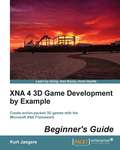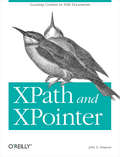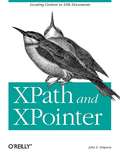- Table View
- List View
Xcode 7 Essentials - Second Edition
by Jayant Varma Brett OhlandStep up your iOS development with the power and wealth of features of Xcode 7 About This Book * Updated for the latest Xcode 7 release, this is the first book that will show you how to use all the new features available in Xcode 7 to their fullest * This guide to will get you up and running with the entire workflow to develop Apple apps without previous Xcode experience * Packed with plenty of tips on how to use Xcode with Swift 2 and other existing Apple frameworks to develop robust apps at a rapid pace Who This Book Is For If you are a novice programmer who is familiar with the concepts of object-oriented programming, but have little to no knowledge of Swift, Xcode, or Apple's Cocoa APIs, then this book is for you. Starting with an introduction to the basics of Xcode and the Swift programming language, you will learn all of the skills that are essential to build an app and submit it to the App Store What You Will Learn * Get an introduction to Xcode and get to know how to navigate and use the tool * Build playgrounds to learn and explore the environment * Create an adaptive UI with the interface builder that will help your app to scale through a wide range of devices * Understand Table, Collection, and Stack views and find out how they can be implemented * Create custom components for your application through frameworks and live previews * Exploit Xcode's advanced features to elevate your debugging and testing capabilities * Run your application on the physical device and submit it to the App store In Detail Apple's Xcode technology is making the development curve smoother than it has ever been with its easy-to-develop features and enhancements. With the latest release of Xcode 7, Apple has also added great support for Swift development. This book will introduce you to all the new features of Xcode 7 and demonstrate how Swift programming can be much easier, faster, and simply better with Xcode! Even if you're starting with just a little knowledge of Swift or Xcode, you will learn the basics of the language as well as the tool. You will then use this knowledge to create simple applications and will learn how to debug and optimize your code. At the end of this book, you would have learned enough to build, run and submit your very own application to the App Store. Style and approach This is a step-by-step guide, full of practical and real world examples, to help you get to grips with Xcode with ease. A demo project is also provided at the end of the book, where you can test your skills.
Xcode Treasures: Master the Tools to Design, Build, and Distribute Great Apps
by Chris AdamsonLearn the critical tips and techniques to make using Xcode for the iPhone, iPad, or Mac easier, and even fun. Explore the features and functionality of Xcode you may not have heard of. Go under the hood to discover how projects really work, so when they stop working, you'll know how to fix them. Explore the common problems developers face when using Xcode, and find out how to get the most out of your IDE. Dig into Xcode, and you'll discover it's richer and more powerful than you might have thought. Get a huge productivity boost by working with Xcode instead of against it. Instead of hacky code fixes and manual processes, once you know the the why and how of Xcode's process, you'll discover that doing things Xcode's way makes your app development more elegant and less aggravating. Explore the major features of Xcode: project management, building UIs with storyboards, code editing, compiling apps, fixing bugs and performance problems, unit- and UI testing, and source code management. Go beyond the basics and explore tasks that professionals deal with when they're working on big projects. Create storyboards that many developers can work on at once, even as projects grow to hundreds or thousands of files. Find the tools that make the code editor pleasant to work with, even in long coding sessions. Discover the right way to find and fix bugs when you have lots of code that's not always playing nicely together.Dig into specific and little-discussed features that help developers on Apple's other platforms: macOS, watchOS, and tvOS. When you're ready to distribute your app, learn how Apple's code-signing system really works. Find out when to let Xcode handle it automatically, and how to do it manually when needed. Discover how much easier and more fun iOS development is when you know the secrets of the tools. What You Need:This book requires Xcode 9 and a Mac running macOS High Sierra (10.13.2) or later. Additionally, an iOS device is recommended for on-device testing but not required.
XDA Developers' Android Hacker's Toolkit
by Jason Tyler Will VerduzcoMake your Android device truly your ownAre you eager to make your Android device your own but you're not sure where to start? Then this is the book for you. XDA is the world's most popular resource for Android hacking enthusiasts, and a huge community has grown around customizing Android devices with XDA. XDA's Android Hacker's Toolkit gives you the tools you need to customize your devices by hacking or rooting the android operating system.Providing a solid understanding of the internal workings of the Android operating system, this book walks you through the terminology and functions of the android operating system from the major nodes of the file system to basic OS operations. As you learn the fundamentals of Android hacking that can be used regardless of any new releases, you'll discover exciting ways to take complete control over your device.Teaches theory, preparation and practice, and understanding of the OSExplains the distinction between ROMing and themingProvides step-by-step instructions for Droid, Xoom, Galaxy Tab, LG Optimus, and more Identifies the right tools for various jobs Contains new models enabling you to root and customize your phoneOffers incomparable information that has been tried and tested by the amazing XDA community of hackers, gadgeteers, and techniciansXDA's Android Hacker's Toolkit is a simple, one-stop resource on hacking techniques for beginners.
Xen Virtualization
by Prabhakar ChagantiEach chapter is a collection of practical tasks that demonstrate how to achieve common virtualization tasks ou then learn how it works so that you can apply this knowledge to your Xen installation and environment. This book is for Linux administrators who want to use Xen virtualization for development, testing, virtual hosting, or operating systems training.
XenServer Administration Handbook: Practical Recipes for Successful Deployments
by Tim Mackey J. K. BenedictPacked with practical advice, this hands-on guide provides valuable information you need to most effectively optimize and manage the XenServer open source virtualization platform. Whether you run a modest installation of a few blades or multiple global enterprise datacenters, this book focuses on the most critical issues you're likely to encounter when designing a XenServer deployment and helps you handle day-to-day management tasks.Tim Mackey and J.K. Benedict from Citrix Systems, the company that manages XenServer, show you how to design a deployment through best practices, deployment blueprints, and installation guidelines. The book's second part features concise, easy-to-implement recipes for day-to-day management, such as user rights, backup strategies, and hardware maintenance.Learn precisely what makes a XenServer work, and how it can host 1000 virtual machinesExplore the core components of a production XenServer environmentInvestigate several options on how and where to install XenServerExamine several factors for "right sizing" your XenServer deployment to fit your needsWork with a decision tree to optimize your XenServer deployment designUnderstand how to accommodate guest VM virtualization modesUse recipes that help you plan for, obtain, and apply XenServer upgrades
Xero For Dummies
by Heather SmithYour comprehensive guide to using Xero Keeping your business running smoothly has never been easier with Xero. You’re in good hands with Xero For Dummies, the only book endorsed by Xero. With the tips and tricks included in this helpful guide, you can easily tackle tasks like accounts payable, invoices, and estimates. It’s packed with easy to follow explanations and instructions on how to use this popular accounting software. It’s like having a personal accountant at your fingertips! The latest update to this useful reference shows how you can use Xero for more than a simple spreadsheet. It includes how to set up your account from scratch, convert your business from another accounting software to Xero, and use Xero to its full potential. It includes these essential topics: Customize the Xero set-up for your business Manage your daily activities with contacts, accounts, sales, and payables Organize suppliers and customers Automate your weekly and monthly reporting routines Track inventory and monitor your business Sync seamlessly across other business platformsFilled with real-world scenarios that shows how you can use Xero every day in your business, Xero For Dummies can help you get your paperwork done quickly, so you can spend your valuable time running your business. Pick up your copy of Xero For Dummies to make that your reality.
XForms Essentials
by Micah DubinkoXForms Essentials is an introduction and practical guide to the new XForms specification. Written by Micah Dubinko, a member of the W3C XForms working group and an editor of the specification, the book explains the how and why of XForms, showing readers how to take advantage of them without having to write their own code. You'll learn how to integrate XForms with both HTML and XML vocabularies, and how XForms can simplify the connection between client-based user input and server-based processing. If you work with forms, HTML, or XML information, XForms Essentials will provide you with a much simpler route to more sophisticated interactions with users.
XML: DTD, XML-Schema, XPath, XQuery, XSL-FO, SAX, DOM
by Margit BecherDie Bedeutung von XML für eine Layout-unabhängige Beschreibung von Dokumenten und damit als Ausgangsformat für Single-Source-Publishing sowie als Austauschformat beim elektronischen Datenaustausch ist heute unstrittig. Anhand vieler Beispiele lernen Sie, wie mit den Sprachen DTD und XML-Schema eigene Auszeichnungssprachen definiert werden können. Ein weiterer Schwerpunkt dieses Buches bildet eine fundierte Einführung in Technologien zur Weiterverarbeitung von XML: XPath, XQuery und XSLT.
XML and InDesign: Stylish Structure: Publishing XML with Adobe InDesign
by Dorothy J. HoskinsFrom Adobe InDesign CS2 to InDesign CS5, the ability to work with XML content has been built into every version of InDesign. Some of the useful applications are importing database content into InDesign to create catalog pages, exporting XML that will be useful for subsequent publishing processes, and building chunks of content that can be reused in multiple publications. New coverage includes Export in XML order for EPUB (CS5.5 and later) and some new code examples for that process, perhaps some sample GREP to map content to XML, and strategies and settings for the export to EPUB.
XML For Dummies
by Ed Tittel Lucinda DykesSee how XML works for business needs and RSS feedsCreate consistency on the Web, or tag your data for different purposesTag -- XML is it! XML tags let you share your format as well as your data, and this handy guide will show you how. You'll soon be using this markup language to create everything from Web sites to business forms, discovering schemas and DOCTYPES, wandering the Xpath, teaming up XML with Office 2003, and more.Discover how to* Make information portable* Use XML with Word 2003* Store different types of data* Convert HTML documents to XHTML* Add CSS to XML* Understand and use DTDs
XML Hacks
by Michael FitzgeraldDevelopers and system administrators alike are uncovering the true power of XML, the Extensible Markup Language that enables data to be sent over the Internet from one computer platform to another or one application to another and retain its original format. Flexible enough to be customized for applications as diverse as web sites, electronic data interchange, voice mail systems, wireless devices, web services, and more, XML is quickly becoming ubiquitous. XML Hacks is a roll-up-your-sleeves guide that distills years of ingenious XML hacking into a complete set of practical tips, tricks, and tools for web developers, system administrators, and programmers who want to go far beyond basic tutorials to leverage the untapped power of XML. With plenty of useful real-world projects that illustrate how to define, read, create, and manipulate XML documents, XML Hacks shows readers how to put XML's power to work on the Internet and within productivity applications. Each Hack in this book can be read easily in a few minutes, saving programmers and administrators countless hours of searching for the right answer. And this is an O'Reilly Hacks book, so it's not just practical, imminently useful, and time-saving. It's also fun. From Anatomy of an XML Document to Exploring SOAP Messages XML Hacks shows you how to save time and accomplish more with fewer resources. If you want much more than the average XML user--to explore and experiment, do things you didn't know you could do with XML, discover clever shortcuts, and show off just a little--this invaluable book is a must-have.
XML in a Nutshell
by Elliotte Rusty Harold W. Scott MeansIf you're a developer working with XML, you know there's a lot to know about XML, and the XML space is evolving almost moment by moment. But you don't need to commit every XML syntax, API, or XSLT transformation to memory; you only need to know where to find it. And if it's a detail that has to do with XML or its companion standards, you'll find it--clear, concise, useful, and well-organized--in the updated third edition of XML in a Nutshell. With XML in a Nutshell beside your keyboard, you'll be able to: Quick-reference syntax rules and usage examples for the core XML technologies, including XML, DTDs, Xpath, XSLT, SAX, and DOM Develop an understanding of well-formed XML, DTDs, namespaces, Unicode, and W3C XML Schema Gain a working knowledge of key technologies used for narrative XML documents such as web pages, books, and articles technologies like XSLT, Xpath, Xlink, Xpointer, CSS, and XSL-FO Build data-intensive XML applicationsUnderstand the tools and APIs necessary to build data-intensive XML applications and process XML documents, including the event-based Simple API for XML (SAX2) and the tree-oriented Document Object Model (DOM) This powerful new edition is the comprehensive XML reference. Serious users of XML will find coverage on just about everything they need, from fundamental syntax rules, to details of DTD and XML Schema creation, to XSLT transformations, to APIs used for processing XML documents. XML in a Nutshell also covers XML 1.1, as well as updates to SAX2 and DOM Level 3 coverage. If you need explanation of how a technology works, or just need to quickly find the precise syntax for a particular piece, XML in a Nutshell puts the information at your fingertips. Simply put, XML in a Nutshell is the critical, must-have reference for any XML developer.
XML in a Nutshell, 2nd Edition
by Elliotte Rusty Harold W. Scott MeansThis powerful new edition provides developers with a comprehensive guide to the rapidly evolving XML space. Serious users of XML will find topics on just about everything they need, from fundamental syntax rules, to details of DTD and XML Schema creation, to XSLT transformations, to APIs used for processing XML documents. Simply put, this is the only reference of its kind among XML books.
XML Pocket Consultant
by William R. StanekBuild and support dynamic, Web-enabled documents with this indispensable guide to XML. This pocket-sized resource zeroes in on the latest XML standards and technologies, including Extensible Stylesheet Language (XSL), XML schemas, XLink, and XPath--delivering critical details through quick-reference tables, step-by-step instructions, lists, and code samples. It's the precise information you need to solve problems and get the job done--no matter what kind of content you want to get on line! GET FAST FACTS TO: Understand XML fundamentals, including naming rules Describe data structure using DTDs Achieve greater power and flexibility with XML schemas Get at-a-glance reference to schema declarations Use namespaces to avoid naming conflicts Create rich formatting with XSL stylesheets Build links to and extract database information Structure XML data dynamically using XSL Transformations and XPath Create hypertext references with XLink and XPointer
XML Pocket Reference: Extensible Markup Language (Pocket Reference (O'Reilly))
by Simon St. Laurent Michael FitzgeraldXML, the Extensible Markup Language, is everywhere: the syntax of choice for newly designed document formats across almost all computer applications. Now used daily by developers, XML is living up to its reputation as one of the most important developments in document interchange in the history of computing. A perennial bestseller, the handy XML Pocket Reference from O'Reilly has been revised once again to give you quick access to the latest goods. In addition to its comprehensive look at XML, this third edition has been updated with new material on Namespaces and XML Schema--considered among the most important elements in current XML use--along with RELAX NG and Schematron, additional powerful tools for describing XML document structures. Like other titles in O'Reilly's Pocket Reference series, the XML Pocket Reference, 3rd Edition features a well-organized format that gets right to the point. As a result, it's already won over the allegiance of developers everywhere. If you need XML answers quick and on the fly, this compact book is most definitely the book for you.
XML Pocket Reference, 2nd Edition
by Robert EcksteinThe XML Pocket Referenceis both a handy introduction to XML terminology and syntax, and a quick reference to XML instructions, attributes, entities, and datatypes. Although XML itself is complex, its basic concepts are simple. This small book combines a perfect tutorial for learning the basics of XML with a reference to the XML and XSL specifications. The new edition introduces information on XSLT (Extensible Stylesheet Language Transformations) and Xpath.
XML Publishing with Adobe InDesign
by Dorothy HoskinsFrom Adobe InDesign CS2 to InDesign CS5, the ability to work with XML content has been built into every version of InDesign. Some of the useful applications are importing database content into InDesign to create catalog pages, exporting XML that will be useful for subsequent publishing processes, and building chunks of content that can be reused in multiple publications. In this Short Cut, we'll play with the contents of a college course catalog and see how we can use XML for course descriptions, tables, and other content. Underlying principles of XML structure, DTDs, and the InDesign namespace will help you develop your own XML processes. We'll touch briefly on using InDesign to "skin" XML content, exporting as XHTML, InCopy, and the IDML package. The Advanced Topics section gives tips on using XSLT to manipulate XML in conjunction with InDesign.
XML Publishing with AxKit
by Kip HamptonWeb developers rely on XML to separate data from presentation and create a consistent templating system for a web site. Although limited XML-to-HTML conversion is possible within some browsers, web developers creating dynamic or complex sites will find server-side XML transformation a necessity. Unfortunately, until recently, there have been few XML tools available for server-side XML transformation or authoring. AxKit, a mod_perl and Apache-based XML content delivery solution, was designed to meet that need with a cost-effective and efficient plugin architecture. AxKit allows the developer to quickly design modules to create faster web sites, and deliver them in a wide variety of media formats. AxKit also takes care of caching so the developer doesn't have to worry about it. AxKit meets the demands of the web developer nicely, but, as with any new toolkit, there is a learning curve. For developers who want to flatten that learning curve and get right to work with AxKit, XML Publishing with AxKit provides detailed information on how to install, configure, and deploy AxKit effectively. The first book solely devoted to AxKit, XML Publishing with AxKit also offers a concise and focused look at how to create XSLT and XPathScript-based pipelines for XML data transfer. This solidly useful new book presents web programmers with the hands-on knowledge they need to get really creative with AxKit. It features a thorough introduction to XSP (extensible Server Pages), which applies the concepts of Server Pages technologies (embedded code, tag libraries, etc) to the XML world, and covers integrating AxKit with other tools such as Template Toolkit, Apache:: Mason, Apache::ASP, and plain CGI. The book also includes invaluable reference sections on configuration directives, XPathScript, and XSP. With XML Publishing with AxKit , web developers will have all the tools they need to deliver complex XML-based systems quickly, the power to develop their own systems for style sheet negotiation, and the flexibility to design completely new style sheet languages. XML Publishing with AxKit gives those new to XML all the background and the courage they need to jump right in and deploy AxKit. And it gives XML-savvy professionals everything they need to hit the ground running.
XML Schema
by Eric van der VlistIf you need to create or use formal descriptions of XML vocabularies, the W3C's XML Schema offers a powerful set of tools for defining acceptable document structures and content. An alternative to DTDs as the way to describe and validate data in an XML environment, XML Schema enables developers to create precise descriptions with a richer set of datatypes?such as booleans, numbers, currencies, dates and times?that are essential for today?s applications. Schemas are powerful, but that power comes with substantial complexity. This concise book explains the ins and outs of XML Schema, including design choices, best practices, and limitations. Particularly valuable are discussions of how the type structures fit with existing database and object-oriented program contexts. With XML Schema, you can define acceptable content models and annotate those models with additional type information, making them more readily bound to programs and objects. Schemas combine the easy interchange of text-based XML with the more stringent requirements of data exchange, and make it easier to validate documents based on namespaces. You?ll find plenty of examples in this book that demonstrate the details necessary for precise vocabulary definitions. Topics include: Foundations of XML Schema syntax Flat, "russian-doll", and other schema approaches Working with simple and complex types in a variety of contexts The built-in datatypes provided by XML Schema Using facets to extend datatypes, including regular expression-based patterns Using keys and uniqueness rules to limit how and where information may appear Creating extensible schemas and managing extensibility Documenting schemas and extending XML Schema capabilities through annotations In addition to the explanatory content, XML Schemaprovides a complete reference to all parts of both the XML Schema Structures and XML Schema Datatypes specifications, as well as a glossary. Appendices explore the relationships between XML Schema and other tools for describing document structures, including DTDs, RELAX NG, and Schematron, as well as work in progress at the W3C to more tightly integrate XML Schema with existing specifications. No matter how you intend to use XML Schema - for data structures or document structures, for standalone documents or part of SOAP transactions, for documentation, validation, or data binding ? all the foundations you need are outlined in XML Schema.
XMPP: Building Real-Time Applications with Jabber Technologies
by Peter Saint-Andre Kevin Smith Remko TronçonThis practical book provides everything you need to know about the Extensible Messaging and Presence Protocol (XMPP). This open technology for real-time communication is used in many diverse applications such as instant messaging, Voice over IP, real-time collaboration, social networking, microblogging, lightweight middleware, cloud computing, and more. XMPP: The Definitive Guide walks you through the thought processes and design decisions involved in building a complete XMPP-enabled application, and adding real-time interfaces to existing applications. You'll not only learn simple yet powerful XMPP tools, but you'll also discover, through real-world developer stories, how common XMPP "building blocks" can help solve particular classes of problems. With this book, you will: Learn the basics of XMPP technologies, including architectural issues, addressing, and communication primitives Understand the terminology of XMPP and learn about the wealth of XMPP servers, clients, and code libraries Become familiar with the XMPP concepts and services you need to solve common problems Construct a complete business application or real-time service with XMPP Every day, more software developers and service providers are using XMPP for real-time applications, and with the help of XMPP: The Definitive Guide, you can, too.
XNA 4.0 Game Development by Example: Beginner's Guide
by Kurt JaegersThis book is a step-by-step tutorial that includes complete source code for all of the games covered. It adopts an engaging style to teach all the game development concepts. Each block of code is explained, and game development concepts are diagrammed and covered in detail. Each game begins with a concept description and concludes with suggestions for expanding on the finished game. If you are an aspiring game developer who wants to take a shot at creating games for the Microsoft Windows platform with the XNA Framework, then this book is for you. Using this book, you can get started with creating games without any game development experience. A basic knowledge of C# would be helpful to kick-start your game development, but it's not essential.
XNA 4.0 Game Development by Example: Beginner's Guide – Visual Basic Edition
by Kurt JaegersThis book is a step-by-step tutorial that includes complete source code for all of the games covered. It adopts an engaging style to teach all the game development concepts. Each block of code is explained, and game development concepts are diagrammed and covered in detail. Each game begins with a concept description and concludes with suggestions for expanding on the finished game. If you are an aspiring game developer who wants to take a shot at creating games for the Microsoft Windows platform with the XNA Framework, then this book is for you. Using this book, you can get started with creating games without any game development experience. A basic knowledge of Visual Basic would be needed to kickstart your game development.
XNA 4 3D Game Development by Example: Beginner's Guide
by Kurt JaegersThis book is a step-by-step tutorial that includes complete source code for all of the games covered. It adopts an engaging style to teach all the game development concepts. Each block of code is explained, and game development concepts are diagrammed and covered in detail. Each game begins with a concept description and concludes with suggestions for expanding on the finished game. This book is intended for readers who want to create 3D games using the XNA Framework. Basic knowledge of the C# programming language and 2D XNA concepts are helpful, but not required.
XPath and XPointer
by John SimpsonReferring to specific information inside an XML document is a little like finding a needle in a haystack: how do you differentiate the information you need from everything else? XPath and XPointer are two closely related languages that play a key role in XML processing by allowing developers to find these needles and manipulate embedded information. XPath describes a route for finding specific items by defining a path through the hierarchy of an XML document, abstracting only the information that's relevant for identifying the data. XPointer extends XPath to identify more complex parts of documents. The two technologies are critical for developers seeking needles in haystacks in various types of processing. XPath and XPointer fills an essential need for XML developers by focusing directly on a critical topic that has been covered only briefly. Written by John Simpson, an author with considerable XML experience, the book offers practical knowledge of the two languages that underpin XML, XSLT and XLink. XPath and XPointer cuts through basic theory and provides real-world examples that you can use right away. Written for XML and XSLT developers and anyone else who needs to address information in XML documents, the book assumes a working knowledge of XML and XSLT. It begins with an introduction to XPath basics. You'll learn about location steps and paths, XPath functions and numeric operators. Once you've covered XPath in depth, you'll move on to XPointer--its background, syntax, and forms of addressing. By the time you've finished the book, you'll know how to construct a full XPointer (one that uses an XPath location path to address document content) and completely understand both the XPath and XPointer features it uses. XPath and XPointer contains material on the forthcoming XPath 2.0 spec and EXSLT extensions, as well as versions 1.0 of both XPath and XPointer. A succinct but thorough hands-on guide, no other book on the market provides comprehensive information on these two key XML technologies in one place.
XPath and XPointer
by John E. SimpsonReferring to specific information inside an XML document is a little like finding a needle in a haystack. XPath and XPointer are two closely related languages that play a key role in XML processing by allowing developers to find these needles and manipulate embedded information. By the time you've finished XPath and XPointer , you'll know how to construct a full XPointer (one that uses an XPath location path to address document content) and completely understand both the XPath and XPointer features it uses.
